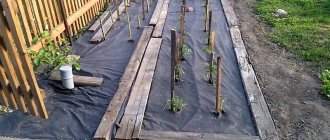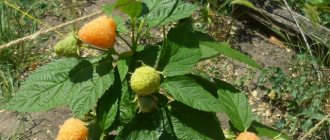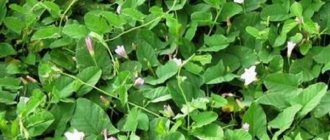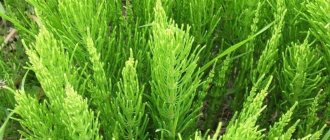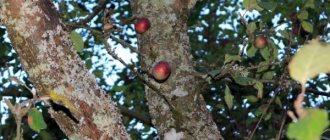How can you get rid of raspberries on your site forever: from young shoots, old bushes
Raspberries are considered one of the most delicious berries. It is used to prepare delicious desserts and winter preserves. Its disadvantage is its involuntary growth. Therefore, some gardeners put a lot of effort into getting rid of it.
Why is it hard to get rid of raspberries?
When a person thinks about why it is difficult to get rid of raspberries, he must take into account several basic structural features of this crop. Berry bushes have an unusual root system and different propagation methods.
Every gardener who grows raspberries in his garden tries to create comfortable conditions for them. But there is a certain category of people who, on the contrary, are trying to eradicate this crop in the garden.
And this complex process is approached with all responsibility.
Important! The complex root system of perennial raspberries helps it cope with many adverse situations, surviving under any conditions.
Raspberry root system
If we consider the features of the raspberry root system, we distinguish several stages of its development:
- a seedling suitable for planting consists of a rhizome and a main stem. After a few weeks, replacement shoots form on the rhizome;
- independent bushes are connected to their parents by rhizomes;
- after harvesting, the upper part of the bush dies, but the root remains unchanged and produces new shoots;
- Every year, offspring are formed on horizontal buds. They receive nutrients and moisture from the parent bush;
- if the bush dies, then the root system of the young seedling becomes independent, forming a separate plant.
Raspberry root system: 1 - two-year-old fruitful shoot, 2 - lateral branches, 3 - replacement shoot, 4 - suckers, 5 - etiolated (unlit shoots), 6 - roots, 7 - buds on the roots, 8 - rhizome.
Raspberry propagation
Among the common methods of propagating raspberries are:
- Green cuttings .
If you want to preserve varietal qualities, then this method will allow you to do this. A small seedling is trimmed so that its length is 8–10 cm. After this, it is placed in a solution that contains a growth stimulator (“Kornevin”, “Heteroauxin” or growth powder). The planting material is kept in such conditions for 15 hours. After this time, the cuttings are planted in the soil and covered with plastic film. Maintain the optimal distance when planting (no more than 10 cm between bushes). Within a month, the cuttings will take root in the soil and grow. Important! If raspberries were propagated using green cuttings, then the temperature should be within +25°C. If the root cutting method was used, then the temperature is maintained in the range of +25...+30°C. - Root cuttings . First, determine what a root cutting is. Based on the structural features of the raspberry, it is a root element that has a side branch. The root thickness should be between 2–3 mm. The reproduction process consists of several stages. First, small grooves are dug (up to 5 cm deep), inside which planting material is installed. After this, it is watered with 2 liters of warm water and covered with film.
Effective ways to get rid of raspberries on your site
If a gardener is thinking about how to remove raspberries from a garden plot, he uses different methods. Some of them do not end with a positive result.
Others allow you to remove unnecessary plants, but over a long period of time, so it is recommended to study in advance all existing methods and features of their implementation.
This way you will be confident that all your actions will be crowned with success.
Uprooting old bushes
A common reason why it is necessary to uproot old bushes is the lack of berries on them. This process is best carried out in the spring. Secateurs are used as tools.
If your raspberry garden is in a neglected state, then it is better to use a shovel or an ax. First, the branches are cut off so that no more than 10 cm remains above the ground.
After this, they dig up the entire garden where this crop grows, removing all elements of the root system.
https://www.youtube.com/watch?v=lGnJZAWpzuY
Read the rules for autumn planting raspberries.
Deepen the shovel by 1 bayonet, dig up the bush and carefully remove it from the ground.
There is a possibility that small roots will be torn off and remain in the soil, so in the fall you will have to dig up the garden plot again and select the remaining parts of the raspberries.
If the gardener uproots the raspberry tree to begin construction, rather than planting new plants, then the task will be easier. To do this, in November they dig up the ground and sprinkle it with salt. Its layer should be within 5–10 mm.
Uprooting young shoots
Many gardeners and summer residents face problems growing raspberries. Every year they remove unnecessary shoots, and with the arrival of spring even more of them appear. Raspberries are transplanted at intervals of 5 years. It is extremely important to combat shoots, as they negatively affect the crop. If young growth has appeared recently, then it is not difficult to remove it.
It is enough to dig up the area and remove all the roots from the soil. If you are not sure that you have eradicated all parts of the root system, then in April, when the grass comes up, you need to dig up the ground again. To prevent the growth of raspberries, it is enough to plant crops such as potatoes, tomatoes or carrots next to them.
They will crowd out berry bushes, thereby simplifying the task for the summer resident. In the gardening sphere, shoots are the enemy of raspberries, which take all the nutrients and provoke a decrease in the size of the berries. It also negatively affects the taste of the product. When growing raspberries, a gardener may encounter many troubles.
To avoid them, you must adhere to certain precautions:
- Wear closed, tight clothing. This is due to the fact that raspberry bushes are covered with small thorns that can injure yourself.
- Use sharp tools. This way you will put less effort during all actions.
- An equally mandatory precaution is the use of respirators and safety glasses . They are necessary if you will be using pesticides and other chemicals.
Fencing raspberry fields deep into the ground
To stop the growth of raspberries in the area, it is enough to use fences deep into the soil. They are installed before planting crops to stop the development of the root system.
This way you will be sure that the roots will not extend beyond the raspberry tree.
The process of fencing a raspberry tree deep into the ground involves using dense materials (slate, crushed stone, metal sheets, border tape, plastic or roofing felt). First, trenches are dug.
Based on the developed root system, their depth should be 50–60 cm. Use material whose width is at least 1 cm. After this, the walls of the recess are covered with the selected material and filled with soil.
To prevent gaps from forming, you will need to compact it thoroughly. Such barriers have a positive effect on crop productivity. Because
it will not grow beyond the allotted space; more berries will form on the bushes.
How to prevent raspberries from moving from neighbors
If you want to protect your site from raspberries from your neighbors, you can use several methods:
- Installing barriers to prevent roots from reaching you. The essence of installing barriers is indicated above.
- Spraying the area with pesticides or saline solution. The only drawback of the saline solution is that no plants can be planted in the area where it is used.
Removal using pesticides
In the process of getting rid of raspberries, many gardeners use chemicals - pesticides. Most of them are designed to control weeds. Their advantage lies in the fact that a person spends a minimum amount of time and effort. Their disadvantage is the need for repeated processing.
You will be interested to know how black raspberries differ from blackberries.
Effective means
The most common pesticide that gardeners use to control raspberries is Roundup. It is often used to eliminate weeds. It also helps control raspberry overgrowth. It is enough to dilute 2 ampoules of Roundup in 10 liters of warm water and pour the solution over the bushes and soil.
Other equally effective means include:
- “Hurricane” (20 ml per 5 liters of water).
- "Glyfovit" (60 mg per 10 liters of water).
- "Alaz" (100 mg per 5 liters of water).
- "Tornado" (5 ampoules per 10 liters of water).
Application taking into account the possible effect on other plants on the site
If you grow other crops near the raspberry tree, then the use of pesticides should be as careful as possible. Some of them can damage the structure of vegetable crops, destroying their root system.
Find out why raspberry leaves turn yellow.
To reduce the risk of damage to vegetables and fruits growing near raspberries, you must adhere to a number of necessary rules:
- spray and water raspberries at a distance of 2 m from crops;
- if the raspberries are located close, then the bushes located on the border are removed mechanically;
- if necessary, cover vegetable and fruit crops with film or plastic bottles (at the time of processing), and open after 2-3 hours.
Folk ways to get rid of raspberries
Common folk methods for getting rid of raspberries are using salt and vinegar. The disadvantage of such methods is that the site is unsuitable for subsequent plantings. Such substances destroy all useful elements in the soil, and it becomes unsuitable for planting.
It is better to carry out this procedure at the end of autumn, so as not to aggravate the situation under the influence of sunlight. To prepare a saline solution, use 1 kg of table salt diluted in 10 liters of warm water. Water the area so that the solution penetrates to a depth of 5–6 cm.
To prepare another effective remedy, use 2 cups of acetic acid, which is diluted in 5 liters of warm water. Watering is carried out to a depth of 3 cm.
Source: https://fermer.blog/bok/sad/malina/9442-kak-izbavitsja-ot-maliny-na-uchastke.html
How to remove raspberries from the garden?
Raspberries are considered one of the most delicious berries. It is used to prepare delicious desserts and winter preserves. Its disadvantage is its involuntary growth. Therefore, some gardeners put a lot of effort into getting rid of it.
Raspberry growth: how to stop and what to do with it
Raspberries are not only tasty and healthy berries, but also an abundance of young root shoots that strive to win the best places on the site. To prevent this from happening, gardeners have to always be on alert and not let the plant outside the boundaries of the berry garden.
The peculiarity of raspberries is that every year it produces from 3-7 to several dozen root shoots, depending on the variety. They grow as independent shoots not far from the mother bush and rush to fertile lands, giving new growth.
Why you need to fight root growth
For a planted plant, such growth is akin to weeds, because takes away the necessary nutrients from him. It makes the garden unkempt and attracts pests, of which raspberries have quite a lot.
In the absence of shoots, the berry bush develops well and bears fruit, because he gets enough sunlight and nutrition. When blown by the wind, it suffers less from fungal infections. And picking berries from such plantings is much easier than from dense thickets.
Therefore, the fight against root growth is a necessity, and not a momentary whim.
How to get rid of raspberry shoots
To create a berry plantation, many plants are planted on the site at once. Therefore, over time, the number of offspring, if not dealt with, increases exponentially. They spread in different directions and can cover large areas.
There are three ways to get rid of root growth: mechanical, biological and chemical.
photo from nl.blabto.com
It is easiest to remove growth while it is young, and it is even better to prevent it from growing. To do this, during planting, barriers made of pieces of tin, slate or other durable materials must be installed along the perimeter of the row.
The fences should be 40-50 cm wide so that they can be buried 35-45 cm. This is enough to prevent root shoots from going beyond the barrier, because they have a shallow root system, lying at least 25 cm deep. The upper part of the fence, which protrudes a few centimeters above the ground, will be useful when watering and feeding plants.
To limit the growth of root suckers, some gardeners also try to grow raspberries in car tires or buried barrels and buckets without a bottom.
If the growth does appear, then you need to get rid of it immediately. To do this, dig up the area invaded by raspberries, removing all root shoots. Digging may have to be repeated several times during the season. After it, cover the soil with a layer of mulch. After 2-3 weeks, remove this covering and dig up the soil again, removing all the roots that appear.
Cutting out young shoots often leads to their even greater growth, because the roots remain in the soil and sprout new shoots, and the berry bushes become even denser.
Source: https://ivushka23.ru/kak-vyvesti-malinu-s-ogoroda/
Clearing the garden of plants
Before destroying the borer, care must be taken to ensure that it does not spread underground. To do this, you will need to fence the area. Slate, which needs to be buried to a depth of 40 centimeters, helps to achieve the desired goal.
The most effective herbicides against borer:
- Tornado;
- Roundup;
- Killer;
- Sniper;
- Hurricane.
The use of chemicals can adversely affect human and animal health. Therefore, you should work with such products wearing gloves, boots and a respirator.
An effective weed remover is Glyphosad. All of the above herbicides work well against various types of weeds, including weeds. These are pesticides, spraying with which has a negative effect on all plants, including cultivated plants.
It is important to remember that plants get used to such liquids very quickly, so they should be changed periodically
Also a good option for removing weed is the attrition method. To do this, you will need to constantly monitor the young shoots. When the first leaf appears, the plant must be destroyed. You need to cut the seedlings just below the root collar. If you do this correctly and systematically, the plant will not have the strength to develop and will die on its own.
Mature bushes should be removed at soil level. Then water the cut with herbicide. It is recommended to repeat the procedure after 7 days. The first results will be visible within two weeks. This method can also be applied to other types of weed, one of which is burdock.
Based on the options listed above, getting rid of dreaming is not so difficult. Compliance with the rules and sequence of actions will give the desired result. In just a few months, your site will become perfectly clean without losing its fertility.
All ways to remove raspberries from the garden forever: from uprooting to chemicals
How to get rid of raspberries on your property forever? Young growth that has appeared recently can be dealt with by fencing the area. Old bushes are destroyed by uprooting. Chemicals are also used.
Why are there difficulties?
If left untimely and improperly cared for, raspberries grow quickly and overrun the area within a few months. Carrying out gardening work becomes significantly more complicated.
The plant is distinguished by its “survivability”, and it is difficult to remove it from the garden forever: shoots form even from a small piece of root left in the ground.
The best methods for dealing with raspberries:
- fencing the site;
- uprooting;
- use of drugs.
To enhance the effect, it is advisable to use a combination of several methods.
Fencing the site
This method is relevant if raspberries grow onto the site from neighbors living nearby.
To make a special fence you will need:
- insulating material (rubber tires from cars or slate sheets);
- cordon of plants.
Advice: Ruberoid should not be used: it is very fragile, and raspberry roots can easily break through it.
What to do:
- The insulating material is buried to a depth of 600-700 mm. In order to certainly eliminate the risk of penetration of raspberry roots, a distance of 100 cm deep is acceptable.
- The trench should be dug along the fence. The slate is placed vertically. It must first be divided into 3-4 parts. You cannot leave any holes, otherwise the raspberries will enter the area again.
- Additionally, you need to create a reliable cordon from bushes of garlic, parsley, corn or sorrel. Raspberries do not tolerate such proximity and do not pass through these plants. Young shoots are afraid of “green fertilizers” - green manures.
Uprooting
This method involves digging up the area. This must be done at least 2-3 times to destroy the small raspberry roots. Uprooting is carried out at any time of the year, before the soil freezes. The first digging must be carried out immediately after the snow melts, the second - in late spring and early summer.
The process looks like this:
- Cut off the tops of the raspberries using pruning shears (this can be replaced with a hatchet). Distance - 150-200 mm above the ground. This makes it easier to pull out the roots.
- Dig the area deeply.
- Manually select roots.
If the owner of the site does not plan to plant plants in the area under the raspberry tree, then after digging it is recommended to add table salt to the soil.
It is advisable to do this in the fall, before frost sets in. The salt is evenly distributed over the surface. The layer thickness is 0.5 cm. This is a radical method. This area cannot be used for growing plants in the future.
In order to prevent relapse, it is necessary to periodically dig out any growth that forms in the treated area.
If a neighbor's raspberry has formed in an empty area of the plot, it is recommended to mow it with a trimmer. In order to prevent it from growing, a few mowings are enough. In the new gardening season, for prevention purposes, the procedure should be repeated 2-3 times.
Use of drugs
It is necessary to fight growth with the help of “chemistry” when other methods do not give a positive result. Etching is carried out 2-3 times.
The procedure looks like this:
- Dig up the area and remove the roots.
- Cut plants as close to the soil as possible.
- Treat bush cuttings and soil.
The most powerful drugs:
- Alaz. Desiccant and universal herbicide of continuous action. Penetrates into plants through the leaves and is transferred to all parts, including the root system. Death occurs within 5-30 days. Symptoms of herbicide exposure: wilting of leaves, their yellowing and browning.
- Tornado. Universal herbicide of non-selective systemic action. Helps block the synthesis of aromatic amino acids. This leads to damage to growth points. Both aboveground and underground raspberry organs gradually die off. This drug has no effect on seeds. Symptoms appear on days 4–30.
- Agrokiller. A universal weed control product with a high content of active ingredients. Effective against bushes. Penetrates into leaves, stems and roots. Yellowing begins 48-72 hours after treatment. Death - after 15-20 days. To enhance the effect, the drug “Adyu” should be added to the solution.
- Glyfovit. New generation herbicide. The main active ingredient is an inhibitor of the enzymatic system responsible for the synthesis of aromatic amino acids. Penetrates to the root system of the plant through its above-ground parts. The death of shrubs occurs against the background of blocking enzymatic processes.
All herbicides should be used only in dry, sunny weather.
Security measures:
- chemicals must be used with great caution, because they penetrate into the roots. The raspberry shoot has a common root with the mother bush, which can grow with neighbors or be “desired”, intended for harvest;
- if the treatment is carried out during fruiting, the berries will contain elements hazardous to health;
- the hazard class is indicated on the herbicide packaging.
For information Some summer residents recommend using Roundup. This is a very powerful drug that is banned in some countries.
Raspberries are an incredibly resilient and creeping plant, but they are not immortal. By approaching the matter systematically, you can completely and permanently remove unwanted growth from your site.
Source: https://goodgrunt.ru/yagody/kak-izbavitsya-ot-maliny-na-uchastke-navsegda.html
How to get rid of raspberries on your property forever: proven methods
Some types of plants, especially raspberry bushes or wild grapes, are distinguished by a powerful root system. Growing throughout the area of the garden allocated for them, they move further, rapidly filling the neighboring territories. Such “occupation” often interferes and forces you to look for a way to get rid of raspberries on your site forever.
How to grow raspberries: methods
The need to get rid of raspberry bushes arises for various reasons. The main ones:
- old or fungal-damaged shrubs with low yield readings;
- the desire to move the raspberry garden to a new location;
- suppression of growth and fruiting of other crops by raspberries;
- clearing the site for construction and others.
It happens that raspberries move from neighboring areas and interfere with the normal cultivation of garden or garden plants. The roots of the crop grow quickly, are distinguished by their vitality and unpretentiousness; if they are not dealt with, they can destroy the rest of the vegetation.
Owners who grow raspberries know that for a normal berry harvest, it is advisable to change the planting location every 5-7 years. To ensure that the previous plot is not empty after the plant is transferred, it is planted with another crop. But since even a small root in the ground quickly produces new growth, it is important to get rid of raspberry residues.
Eliminate raspberries using one or a combination of methods:
- digging up the area and uprooting the roots;
- use of chemical herbicides;
- covering the area with insulation;
- fencing the territory;
- folk remedies.
The choice of method depends on the subsequent use of the treated area.
How to uproot raspberries on the plot
Complete physical removal of the top and root parts of the plant is the main method of breeding raspberries. Without it, it is difficult to cope with the growth. Uprooting raspberries involves digging up the area, which requires a comfortable shovel with a long blade and a sufficient amount of free time.
It is important to take into account the fact that you will have to dig up the soil at least 2-3 times, since it will not be possible to remove small roots in one go. The technique can be used at any time of the year, with the exception of winter due to the inconvenience and hardness of the soil.
For effectiveness, it is recommended to carry out the first uprooting in early spring after the snow has melted, when the ground has softened. Then, by the end of spring or summer months, the remaining roots will give rise to superficial growth and the procedure will be repeated. Within a year it will be possible to get rid of raspberries on the site.
The uprooting process proceeds according to the following scheme:
- the tops of the raspberries are cut off with pruning shears or a hatchet at a height of 15-20 cm above the ground (for convenient removal of the roots);
- a shovel is used to dig up the area deeply;
- underground parts are removed manually;
- the soil is crushed to remove roots.
If there is not enough time to breed raspberries, then use one more of the above methods. This is the use of chemical herbicides, covering the area or traditional methods.
How to pickle raspberries
The use of chemicals is justified if the site is allocated for further development or other domestic needs. You will have to pickle the raspberries 2-3 times. The soil after such procedures becomes unsuitable for growing other plant crops.
The bush and soil are treated with herbicides, but it is more effective to pre-cut the tops at ground level.
After this, it is recommended to coat the bush sections with undiluted product and spray the soil around the area.
The fact is taken into account that digging up the soil is indispensable. The herbicide destroys the central rhizome, but small shoots will remain and will soon break out. Another method is to combine uprooting and subsequent application of chemicals to the dug up soil.
To eradicate raspberries, they use a continuous action weed and shoot killer called Roundup. The drug is considered strong and effective, but 2-3 repeated treatments of the area will have to be done. Analogues such as Alaz, Tornado, Hurricane, Glifovit are considered alternative options.
How to protect a plot from raspberries
If raspberries are sprouting in the adjacent area, but the neighbors do not plan to get rid of them, it is recommended to install a special fence. For this purpose it is used:
- solid insulating material;
- cordon of some plant species.
Raspberry roots are able to break through fragile materials (roofing felt, for example). For fencing the site, preference is given to sheets of slate or rubber tires from a car.
Restrictors are buried in the soil along the perimeter of the growth of berry plantings to protect other garden or vegetable crops from them. Another use is to protect your own plot from the roots of neighboring raspberries.
The depth of the vertical room of the insulator layers is 60-70 cm. Values up to 100 cm are allowed so that the raspberry roots do not pass under the border.
Another popular option is to plant sorrel, corn, parsley or garlic bushes along the growth cordon. Raspberries do not like such a neighborhood and will not cross the plants. Green manure fertilizers effectively suppress the growth of young raspberry shoots.
Preventing the reappearance of thickets
To get rid of raspberry plantings in a summer cottage or garden plot, and to prevent germination, you need to cover the area with material that does not transmit light. To do this, use dense fiber to cover the surface of the soil.
By next spring, the area will be clear of weeds and raspberries. Planting raspberries in containers without a bottom can limit the rooting of shoots in free space. The amount of shoots can be reduced by applying nitrogen fertilizers in the autumn.
We recommend that you read the reasons why gooseberries do not bear fruit
A raspberry bush can cause a lot of trouble if the rules of agricultural technology are violated. To prevent the reappearance of thickets, it is necessary to carefully destroy all shoots of the previous planting, using complex methods. At the same time, attention should be paid to environmentally friendly methods of eliminating plantings.


